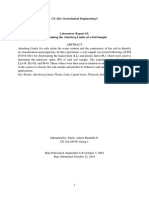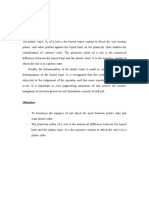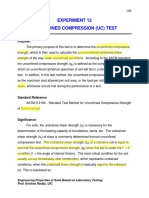Soil Compaction Test: Insitu Density Test Using Sand Cone Replacement Method
Soil Compaction Test: Insitu Density Test Using Sand Cone Replacement Method
Uploaded by
Hu DaCopyright:
Available Formats
Soil Compaction Test: Insitu Density Test Using Sand Cone Replacement Method
Soil Compaction Test: Insitu Density Test Using Sand Cone Replacement Method
Uploaded by
Hu DaOriginal Title
Copyright
Available Formats
Share this document
Did you find this document useful?
Is this content inappropriate?
Copyright:
Available Formats
Soil Compaction Test: Insitu Density Test Using Sand Cone Replacement Method
Soil Compaction Test: Insitu Density Test Using Sand Cone Replacement Method
Uploaded by
Hu DaCopyright:
Available Formats
Faculty of Engineering
KNS2591 Civil Engineering Laboratory 3
Universiti Malaysia Sarawak
SOIL COMPACTION TEST
InSitu density test using Sand Cone Replacement Method
Faculty of Engineering
KNS2591 Civil Engineering Laboratory 3
Universiti Malaysia Sarawak
INTRODUCTION
The field density test is important to measure the amount of compaction achieved in
construction. In the field, compaction is conducted using heavy machinery which consists of
static and vibratory vertical forces. For laboratory compaction test is not directly applicable to
the field compaction because of different compaction effort. In this laboratory test, we use
sand cone replacement method, ASTM D1556 to determine the field density, field moisture
content and dry density.
In sand cone replacement method, a calibrating cylinder is excavated and the weight of
the soil is measured. Sand that has been filled in the calibrating cylinder is measured and
knowing the volume of the calibrating cylinder. The weight excavated from the calibrating
cylinder, the volume of pit, density of the soil is calculated. Therefore, in this experiment
consists of two stages:
1) Calibration of sand density
2) Measurement of sand density
OBJECTIVES
To determine the field density of sand at a given location by sand cone replacement method.
APPARATUS
1) Sand pouring cylinder (sand cone)
2) Calibrating cylinder
3) Metal tray with central hole
4) Dry sand ( passing through 600 micron sieve)
5) Weighing balance
6) Moisture content can
7) Metal tray
8) Scraper tool
9) Knife
10) Spatula
Faculty of Engineering
KNS2591 Civil Engineering Laboratory 3
Universiti Malaysia Sarawak
PROCEDURE
Stage 1 (calibrating of sand density)
1) The internal dimensions of the calibrating cylinder is measured and calculated using
h
the internal formula πd² .
4
2) To avoid spill over, the sand pouring cylinder is filled with sand until the top is 1cm
distance from the upper surface and the weight is measured. (w1)
3) The sand pouring cylinder is placed on a plate. The slit is opened above the cone by
operating the valve. The sand would freely run down until it filled the conical portion.
4) The slit is closed up if there was no further movement of sand in the sand pouring
cylinder. The weight of the sand inside is measured. (w2)
5) The amount of sand in (w2) is placed back to have a same amount in (w1).
6) The sand pouring cylinder is placed concentrically on top of the calibrating cylinder.
The slit is opened up to allow the sand to run until it stopped. The slit is closed and
the weight of remaining sand in the sand pouring cylinder is measured. (w3).
Stage 2 (Measurement of soil density)
1) The ground surface is cleaned up and levelled the ground until it flat.
2) The metal tray with central hole is placed over the flat surface where the field density
is to be determined.
3) The pit is excavated into the ground and must approximately 13.4 deep (same as the
height of the calibrating cylinder).
4) The excavated soil is collected and put into the tray and the weight of the soil is
measured (w).
5) The moisture content of the excavated soil is determined.
6) The sand pouring cylinder is placed over the pit to base of the cylinder that covered
the pit concentrically.
7) The slit is opened up and allowed the sand to run into the pit freely until there was no
movement and closed it.
8) The weight of the sand pouring cylinder with remaining sand (w4) is determined.
You might also like
- Red Triangle Productions LLC - Class Notes For Airbus A320: Phases of FlightDocument15 pagesRed Triangle Productions LLC - Class Notes For Airbus A320: Phases of FlightMa Jo100% (4)
- Atterberg LimitsDocument12 pagesAtterberg LimitscortellaptopNo ratings yet
- Soilmech Lab 1Document10 pagesSoilmech Lab 1Kleinne KristenneNo ratings yet
- Liquid Limit Test of Soil Using Cone Penetrometer MethodDocument2 pagesLiquid Limit Test of Soil Using Cone Penetrometer Methodsamadmsinp100% (1)
- Material LaboratoryDocument14 pagesMaterial LaboratoryAnonymous tLXKwTNo ratings yet
- Determination of Field Density of Soil by Sand Replacement MethodDocument3 pagesDetermination of Field Density of Soil by Sand Replacement MethodAkash SahuNo ratings yet
- Falling Head Permeability Lab ReportDocument11 pagesFalling Head Permeability Lab ReportfatinNo ratings yet
- Unconfined Compression TestDocument6 pagesUnconfined Compression TestBahaaAbdalkareemNo ratings yet
- Specific Gravity of Soil SolidsDocument5 pagesSpecific Gravity of Soil Solidsah maNo ratings yet
- Direct Shear Test ReprtDocument4 pagesDirect Shear Test ReprtShivaraj SubramaniamNo ratings yet
- 9 - Unit Weight of AggregatesDocument8 pages9 - Unit Weight of Aggregateskervin manilaNo ratings yet
- Falling Head Permeability Test Lab ReportDocument7 pagesFalling Head Permeability Test Lab ReportHaziq ZuhaimiNo ratings yet
- Chapter-5, Compaction of SoilDocument71 pagesChapter-5, Compaction of Soilnimeshphuyal789No ratings yet
- Making and Curing Concrete Test Specimens in The Laboratory: Experiment No. 6Document4 pagesMaking and Curing Concrete Test Specimens in The Laboratory: Experiment No. 6Mark Anthony Estoque Dusal0% (1)
- ConclusionDocument1 pageConclusionmacs_smac100% (3)
- Conclusion Soil CompactionDocument1 pageConclusion Soil Compactionlisther t. juyadNo ratings yet
- 2 Determination of in Place Field Soil Density by Using Sand Cone MethodDocument5 pages2 Determination of in Place Field Soil Density by Using Sand Cone MethodGintoki100% (1)
- CMT - Exercise No. 4 - Bulk Unit Weight and Voids in AggregateDocument6 pagesCMT - Exercise No. 4 - Bulk Unit Weight and Voids in Aggregatescisai gandaNo ratings yet
- Unconfined Compression TestDocument4 pagesUnconfined Compression TestRajat KotwalNo ratings yet
- Report-Direct Shear Test 1Document20 pagesReport-Direct Shear Test 1Ash BlackForest50% (2)
- CE162 Lab Report Abstract Atterberg LimitsDocument1 pageCE162 Lab Report Abstract Atterberg LimitsAileen R. FaderNo ratings yet
- Plastic Limit Lab ReportDocument6 pagesPlastic Limit Lab ReportPeter KamauNo ratings yet
- BC ConclusionDocument2 pagesBC ConclusionhaziqNo ratings yet
- 01 Determination of Water ContentDocument4 pages01 Determination of Water ContentAbhijit HavalNo ratings yet
- LAB 5 Permeability TestDocument9 pagesLAB 5 Permeability TestHanis RahamanNo ratings yet
- Phase Relationships ProblemsDocument1 pagePhase Relationships Problemsslawek780303No ratings yet
- Atterberg Limit TestDocument10 pagesAtterberg Limit TestshuhadaNo ratings yet
- Specific Gravity Test Lab ManualDocument3 pagesSpecific Gravity Test Lab Manualmm100% (1)
- Test Title Core CutterDocument8 pagesTest Title Core Cutteraniem_beeNo ratings yet
- Plastic Limit TestDocument9 pagesPlastic Limit TestWilmer FernandezNo ratings yet
- Compaction TestDocument4 pagesCompaction Testmira asyafNo ratings yet
- Soil Investigation Report:: Windy Hill, Central Buyagan, Poblacion, La Trinidad BenguetDocument10 pagesSoil Investigation Report:: Windy Hill, Central Buyagan, Poblacion, La Trinidad BenguetGerry Jimenez Sao-anNo ratings yet
- CMT Lab. 03Document5 pagesCMT Lab. 03John Ceasar PascoNo ratings yet
- Lab Report #03 Particle-Size Analysis Hydrometer (ASTM D-422)Document22 pagesLab Report #03 Particle-Size Analysis Hydrometer (ASTM D-422)eric100% (5)
- Specific Gravity TestDocument7 pagesSpecific Gravity TestChristian BandolaNo ratings yet
- Liquid and Plastic LimitDocument13 pagesLiquid and Plastic LimitDariusAngelitoNo ratings yet
- Experiment 3-Unit WeightDocument7 pagesExperiment 3-Unit WeightkauskakiNo ratings yet
- Lab 10: Modified ProctorDocument20 pagesLab 10: Modified Proctorkim suarezNo ratings yet
- Determination of The Liquid LimitDocument5 pagesDetermination of The Liquid LimitThabo ChuchuNo ratings yet
- 11.initial and Final Setting TimeDocument2 pages11.initial and Final Setting TimeRahul SharmaNo ratings yet
- Slump Test of Portland Cement ConcreteDocument3 pagesSlump Test of Portland Cement ConcreteKevin P MendozaNo ratings yet
- Professor V, Agricultural Machinery Division, Institute of Agricultural Engineering, College of Engineering and Agro-Industrial Technology, UPLBDocument15 pagesProfessor V, Agricultural Machinery Division, Institute of Agricultural Engineering, College of Engineering and Agro-Industrial Technology, UPLBKelvin Michael A. CrystalNo ratings yet
- 1 Laboratory Compaction Test of SoilDocument11 pages1 Laboratory Compaction Test of SoilAnonymous 0blYQJa0KNo ratings yet
- Group 3 (Seksyen4)Document15 pagesGroup 3 (Seksyen4)alnzNo ratings yet
- Soil Compaction LabDocument7 pagesSoil Compaction LabShiva Jake Ramberan100% (1)
- Structural Materials LAB REPORTDocument10 pagesStructural Materials LAB REPORTmusiomi2005No ratings yet
- Lab 1 Direct Shear Lab 1 Direct Shear TestTestDocument9 pagesLab 1 Direct Shear Lab 1 Direct Shear TestTest7e1a8821100% (1)
- Lecture 8 Soil Compaction 2Document26 pagesLecture 8 Soil Compaction 2BruhNo ratings yet
- Plastic LimitDocument9 pagesPlastic LimitPoovan Rajaratnam100% (1)
- Lab Direct Shear Test - NewDocument5 pagesLab Direct Shear Test - NewLaBuHiTamNo ratings yet
- Specific Gravity of Soil SolidsDocument4 pagesSpecific Gravity of Soil Solidspk100% (2)
- Lab Plastic LimitDocument17 pagesLab Plastic LimitnurulselangorNo ratings yet
- Plastic Limit ReportDocument7 pagesPlastic Limit ReportAngelo John R. JavinezNo ratings yet
- Laboratory Report: Field Density TestDocument9 pagesLaboratory Report: Field Density TestMark Gabriel HuertasNo ratings yet
- Experiment 12 Unconfined Compression (Uc) Test: PurposeDocument13 pagesExperiment 12 Unconfined Compression (Uc) Test: PurposeKent Aldwin MangalinoNo ratings yet
- The Nature of SoilsDocument96 pagesThe Nature of SoilsMohammed OumerNo ratings yet
- Constant HEAD ExperimentDocument7 pagesConstant HEAD ExperimentSayed Mahdi Hazheer100% (1)
- Shrinkage Limit PresentationDocument10 pagesShrinkage Limit PresentationMuhammad Ilyas LanjarNo ratings yet
- Numerical Methods and Implementation in Geotechnical Engineering – Part 1From EverandNumerical Methods and Implementation in Geotechnical Engineering – Part 1No ratings yet
- Sand Replacement TestDocument6 pagesSand Replacement Testcinterrrtotebags0% (1)
- Sand Replacement TestDocument4 pagesSand Replacement Testliwor34001No ratings yet
- Faculty of Engineering KNS2591 Civil Engineering Laboratory 3 Universiti Malaysia SarawakDocument3 pagesFaculty of Engineering KNS2591 Civil Engineering Laboratory 3 Universiti Malaysia SarawakHu DaNo ratings yet
- ConclusionDocument2 pagesConclusionHu DaNo ratings yet
- Cross Section of ChannelDocument5 pagesCross Section of ChannelHu Da100% (1)
- MathDocument21 pagesMathHu DaNo ratings yet
- EXCEL SHORTCUTS NINJA - These HotKeys Are The Formula To Easily Double Your Excel Productivity and Perform Your Job Functions Faster! (Excel Ninjas Book 3)Document97 pagesEXCEL SHORTCUTS NINJA - These HotKeys Are The Formula To Easily Double Your Excel Productivity and Perform Your Job Functions Faster! (Excel Ninjas Book 3)madmaxberNo ratings yet
- Singularities PDFDocument5 pagesSingularities PDFVishnu Chemmanadu AravindNo ratings yet
- Database Normalization: Problems Addressed by NormalizationDocument22 pagesDatabase Normalization: Problems Addressed by NormalizationGhouseNo ratings yet
- Com - Pg.game6327838 LogcatDocument28 pagesCom - Pg.game6327838 LogcatDaisy CorbitoNo ratings yet
- BernoulliDocument3 pagesBernoulliomararoofNo ratings yet
- Lecture 6Document16 pagesLecture 6Dina Saad EskandereNo ratings yet
- Kiem Toan Ong Dia Ky Thuat-Cang Ben DamDocument4 pagesKiem Toan Ong Dia Ky Thuat-Cang Ben DamThanh Dinh QuangNo ratings yet
- Power - Quality - Mitigation Technologies in The Distributed Environment - Ebook Antonio Moreno PDFDocument438 pagesPower - Quality - Mitigation Technologies in The Distributed Environment - Ebook Antonio Moreno PDFMadhavi Venkat100% (2)
- Spherical HarmonicsDocument8 pagesSpherical HarmonicsFelipe Barros CárdenasNo ratings yet
- Lecture 3Document40 pagesLecture 3Md. Rakibul IslamNo ratings yet
- Matter - SOL 5.4 - Science Study GuideDocument4 pagesMatter - SOL 5.4 - Science Study GuideTegan HutchinsonNo ratings yet
- Stage Separation of Space Launch VehiclesDocument12 pagesStage Separation of Space Launch Vehiclesvasanraja100% (1)
- Fault Code PDFDocument33 pagesFault Code PDFJORGE DAVID APAZA HURTADO100% (3)
- Enhanced MNC Network ArchitectureDocument11 pagesEnhanced MNC Network ArchitectureAniket NamdeoNo ratings yet
- HFA16PA60CDocument6 pagesHFA16PA60CDwp BhaskaranNo ratings yet
- WWW W3schools Com CPP CPP - Comments AspDocument4 pagesWWW W3schools Com CPP CPP - Comments AspnasserNo ratings yet
- PAG 09.2 - Investigating Capacitors in Series and ParallelDocument3 pagesPAG 09.2 - Investigating Capacitors in Series and ParalleljmsonlNo ratings yet
- waves_&_sound_assignmentDocument2 pageswaves_&_sound_assignmentgobeyondstaffNo ratings yet
- BazzISM2.5.0 ManualDocument9 pagesBazzISM2.5.0 ManualJonEatonNo ratings yet
- Su Dung EEDK MCAFEEDocument31 pagesSu Dung EEDK MCAFEEtuanvukma6bNo ratings yet
- Short Proof of A "Radon-Nikodym Theorem" For Additive FunctionalsDocument4 pagesShort Proof of A "Radon-Nikodym Theorem" For Additive FunctionalsJacek PodlewskiNo ratings yet
- Sample Question Paper Class: Xii Session: 2021-22 Applied Mathematics (Code-241) Term - 1Document6 pagesSample Question Paper Class: Xii Session: 2021-22 Applied Mathematics (Code-241) Term - 1Dp MukherjeeNo ratings yet
- Problem Set 5 Saf PDFDocument2 pagesProblem Set 5 Saf PDFtrols sadNo ratings yet
- Advances in Computer Vision and Pattern RecognitionDocument1 pageAdvances in Computer Vision and Pattern RecognitionDeepak Kumar SinghNo ratings yet
- Audio Video System LabmanualDocument54 pagesAudio Video System LabmanualBhavin GajjarNo ratings yet
- Food Management and Students' Performance in Government-Aided Secondary Schools in Bamunanika, Luwero District, UgandaDocument10 pagesFood Management and Students' Performance in Government-Aided Secondary Schools in Bamunanika, Luwero District, UgandaInternational Journal of Innovative Science and Research TechnologyNo ratings yet
- CE3603 Introduction To Construction Engineering: Read This Page Before StartingDocument7 pagesCE3603 Introduction To Construction Engineering: Read This Page Before StartingryanNo ratings yet
- Vol. 28Document108 pagesVol. 28Guesh GebrekidanNo ratings yet
- 2 Problems: H (M) y (In Other Words, H Is A One-Way, or Preimage Resistant Function)Document22 pages2 Problems: H (M) y (In Other Words, H Is A One-Way, or Preimage Resistant Function)AlexandruTapirdeaNo ratings yet





























































































